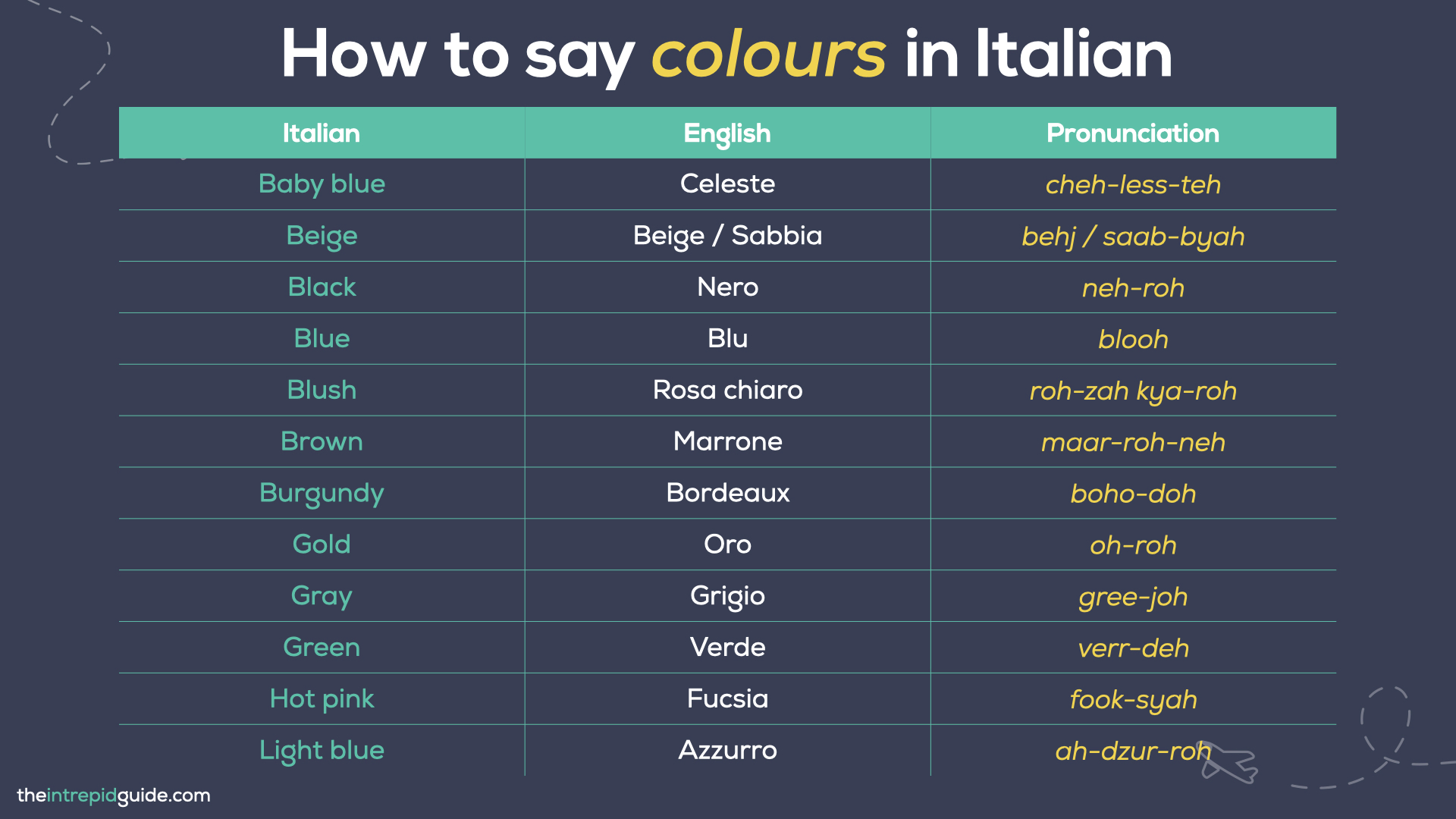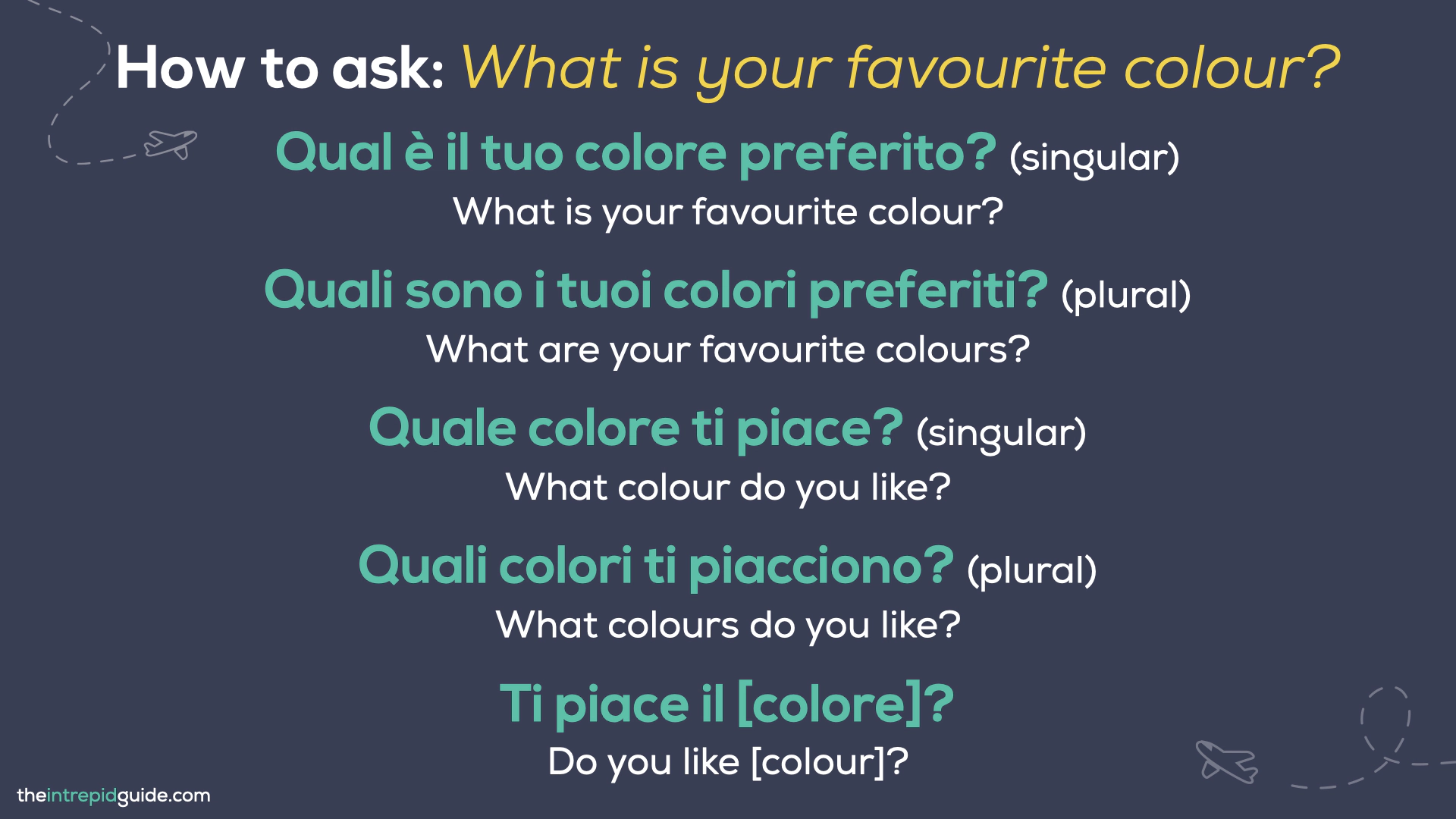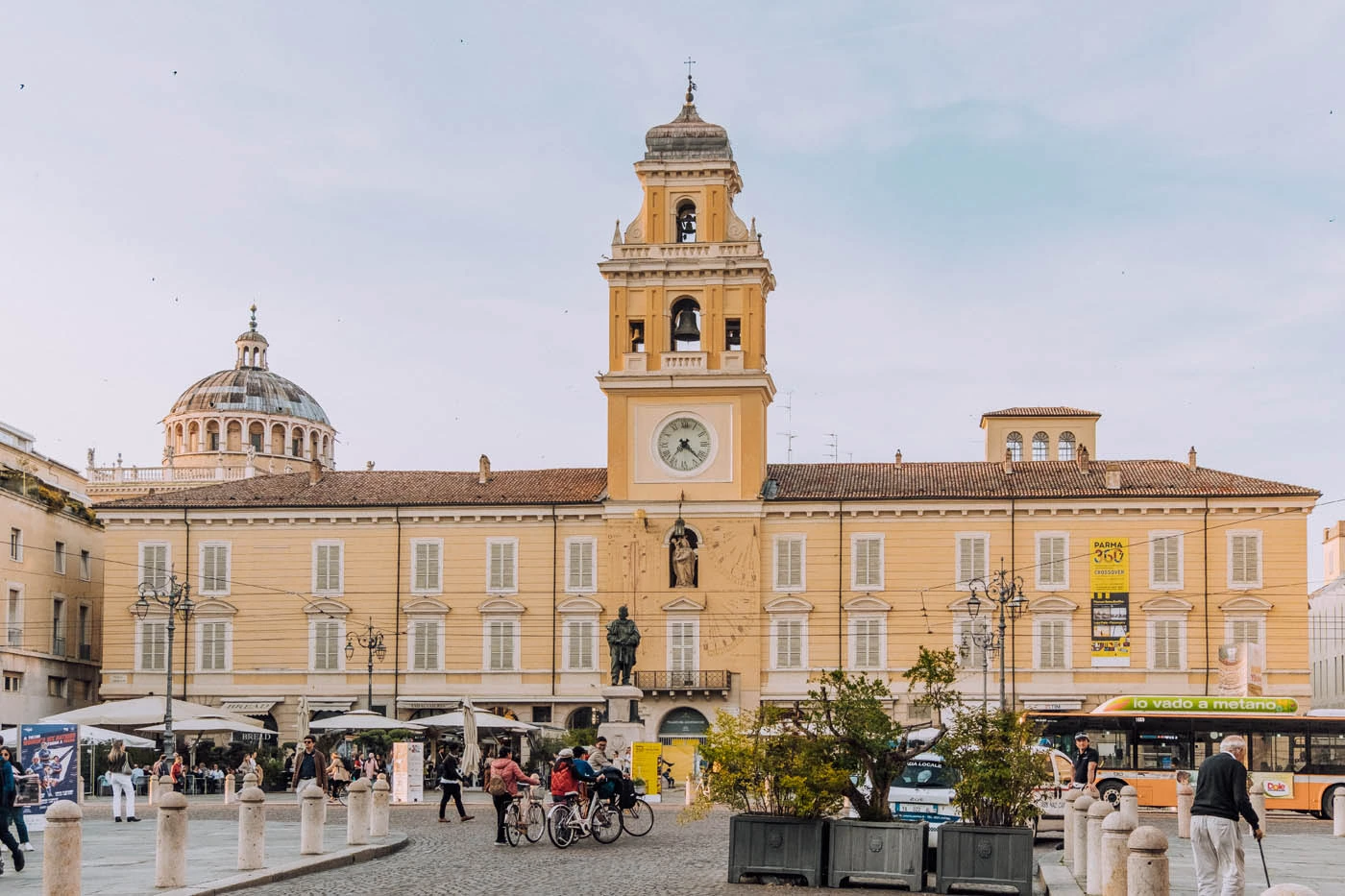As Italian writer Alessandro Baricco wrote in his novel Castelli di Rabbia (Castles of Anger), “A volte le parole non bastano. E allora servono i colori” (Sometimes words are not enough. Then, you need colours). He couldn’t have said it better. Colours are a fundamental part of Italian vocabulary, reflected in many Italian idioms and expressions used in everyday conversations to convey emotions and beliefs.
Knowing how to say colours in Italian will come in handy in many situations, from pointing the exact object you want while shopping in Rome to discussing fine wines in Florence. Plus, learning the names of colours is a great way to improve your Italian accent, as their pronunciation includes many distinct Italian sounds.
But first, make sure to download your free PDF cheat-sheet, which includes all the key points we’ll cover in this guide. Just enter your email below and I’ll send it to you straight away.
By the way, want to improve your Italian quickly and having fun doing it? I thought so! If you’re a beginner, I recommend Intrepid Italian, my comprehensive self-paced programme that teaches you through the power of my unique 80/20 method. The course covers everything you need to know as a beginner in Italian. Join now for lifetime access and my 30-Day “Celebrate with a Spritz” money-back guarantee by clicking here.
Or if you’re already at the intermediate level, why not enrol in Intrepid Italian for Advanced Beginners (A2) or Intrepid Italian for Intermediates (B1), my more advanced programmes that helps you master the trickiest aspects of Italian grammar while as you edge closer to fluency in Italian.
Table to Contents
Here’s what we’ll cover in this guide. Click on any title to jump to each section.
- How to Say Colours in Italian
- How to use colours in Italian as nouns or adjectives
- 7 Ways to use Italian colours in a sentence
- How to ask: What is your favourite colour in Italian?
- Colours in Italian culture
- Unique colours of Italy
- Italian idioms and expressions with colours
How to Say Colours in Italian
 Let’s start with a list of the most common colours you’re most likely to run into in everyday conversations, including their pronunciation.
Let’s start with a list of the most common colours you’re most likely to run into in everyday conversations, including their pronunciation.
| English | Italian | Pronunciation |
|---|---|---|
| Baby blue | Celeste | cheh-less-teh |
| Beige | Beige / Sabbia | behj / saab-byah |
| Black | Nero | neh-roh |
| Blue | Blu | blooh |
| Blush | Rosa chiaro | roh-zah kya-roh |
| Brown | Marrone | maar-roh-neh |
| Burgundy | Bordeaux | boho-doh |
| Gold | Oro | oh-roh |
| Gray | Grigio | gree-joh |
| Green | Verde | verr-deh |
| Hot pink | Fucsia | fook-syah |
| Light blue | Azzurro | ah-dzur-roh |
| Lilac | Lilla | leel-lah |
| Magenta | Magenta | mah-gen-tah |
| Maroon | Granata | grah-nah-tah |
| Mustard | Ocra / Senape | oh-krah / seh-nah-peh |
| Orange | Arancione | ah-raan-choh-neh |
| Pink | Rosa | roh-zah |
| Purple | Viola | vee-oh-la |
| Red | Rosso | ross-soh |
| Silver | Argento | arr-jen-toh |
| Turquoise | Turchese | toor-keh-seh |
| Violet | Viola | vee-oh-lah |
| White | Bianco | bee-ann-coh |
| Yellow | Giallo | jaal-loh |
How to use colours in Italian as nouns or adjectives
When talking about colours in general, they always use the masculine form and are preceded by the definite article il (the):
- Il bianco è il mio colore preferito – White is my favorite colour
- Il nero sta bene con tutto – Black goes with everything
- Il viola porta sfortuna -Purple brings bad luck
When colours are used as adjectives, in most cases, the colour will match the gender and number of the noun it describes. Here are 3 things to remember:
1. Colours ending in -o regularly change to match the gender and number of the noun they refer to. Let’s use grigio (grey) as an example:
- Il cielo è grigio – The sky is grey (masculine singular)
- La macchina è grigia – The car is grey (feminine singular)
- I suoi capelli sono grigi – His hair is grey (masculine plural)
- Le piastrelle sono grigie – The tiles are grey (feminine plural)
Attenzione!: Bianco (white) adds an “h” in the plural form like most Italian adjectives ending in -co, -ca, -go, -ga:
- Il tavolo è bianco – The table is white (masculine singular)
- La gonna è bianca – The skirt is white (feminine singular)
- I tovaglioli sono bianchi – The napkins are white (masculine plural)
- Le pareti sono bianche – The walls are white (feminine plural)
2. Colours ending in -e only change to match the number of the noun they refer to. They end in -e for singular (both masculine and feminine) and -i for plural (both masculine and feminine). Here’s an example with verde (green):
- L’orologio è verde – the watch is green (masculine singular)
- L’erba è verde – the grass is green (feminine singular)
- I prati sono verdi – the lawns are green (masculine plural)
- Le lucertole sono verdi – the lizards are green (feminine plural)
3. Some colours don’t change, no matter the gender or number of the word they’re describing. These include blu (blue), rosa (pink), fucsia (hot pink), viola (purple), lilla (lilac), beige (beige):
- Il cielo è blu – The sky is blue (masculine singular)
- Ho una valigia blu – I have a blue suitcase (feminine singular)
- I miei sandali sono blu – My sandals are blue (masculine plural)
- Mi ha regalato delle rose blu – He gifted me some blue roses (feminine plural)
7 Ways to use Italian colours in a sentence
These are the main rules to keep in mind when using colours in your Italian conversations:
1. Unlike English, where colours precede nouns, Italian places them after the word they’re describing:
- Anna indossa un abito rosso – Anna wears a red dress
- Ho comprato una maglietta bianca da abbinare ai pantaloni neri – I bought a white shirt to match the black trousers
2. To state that something is a certain colour, use the verb essere (to be) followed by the colour:
- La mia macchina è rossa – My car is red
- Le sedie sono nere – The chairs are black
3. If you’re curious about the colour of something, you can ask these questions:
- Di che colore è …? (What colour is…?) for single things, for instance Di che colore è il tuo nuovo vestito? – What colour is your new dress?
- Di che colore sono …? (What colours are…) for plural things, for instance Di che colore sono le scarpe che hai comprato? – What colour are the shoes you bought?
4. To describe shades, use these words after the colour:
- Chiaro (light) as in Un ombretto marrone chiaro (A light brown eyeshadow)
- Scuro (dark) as in Un maglione viola scuro (A dark purple jumper)
- Opaco (matte) as in Un mobile nero opaco (A matte black piece of furniture)
- Brillante (bright) as in Un abito verde brillante (A bright green dress)
- Pastello (pastel) as in Uno smalto rosa pastello (A pastel pink nail polish)
- Slavato – (faded) as in Un jeans blu slavato (A faded blue jeans)
5. Another way to describe shades is by adding names of fruits, animals or things that help convey the depth or intensity of a colour. For instance:
- Giallo limone – lemon yellow
- Giallo canarino – canary yellow
- Grigio perla – pearl gray
- Rosa salmone – salmon pink
- Rosso ciliegia cherry red
- Verde mela – apple green
- Verde militare – army green
- Verde speranza – greenery
6. In Italian, it’s common to use suffixes to modify colors, indicating that they may not be very appealing or precise:
The suffix -astro is for colours that are not well-defined or altered, for example:
- Spesso il cielo assume un colore rossastro all’alba – The sky at dawn often takes on a reddish colour
The suffix -ognolo is for faded or dull tones, for example:
- Quell’amaro verdognolo è una vera bomba – That greenish liquor is a real bomb
The suffix -iccio is for a somewhat unpleasant tone
- Guarda che gambe bianchicce, devo abbronzarmi un pò! – Look at these whitish legs, I need to get a tan!
Fun fact: the adjective bianchiccio is often used to make fun of people who don’t have a tan in summer, there’s even a song for it, Piaccio bianchiccio (People like me whitish)!
7. Finally, here are some useful words to describe something with multiple colors, without specifying a particular shade:
- Colorato (colourful) as in Un vestito colorato (A colourful dress)
- Variopinto (multi-coloured) as in Una carta da parati variopinta (A multi-coloured wallpaper)
- Multicolore (multi-coloured) as in Un paesaggio multicolore (A multicoloured landscape)
Attenzione!: Italians say bianco e nero (white and black) to describe something that lacks colour, like an old movie or a photograph, which is the opposite order of how we say it in English (black and white)!
How to ask: What is your favourite colour in Italian?
 If you want to ask someone “What is your favorite colour?”, there are 3 ways to do it:
If you want to ask someone “What is your favorite colour?”, there are 3 ways to do it:
The classic question: Qual è il tuo colore preferito? (What is your favorite colour?) / Quali sono i tuoi colori preferiti? (What are your favorite colours?)
A casual alternative: Quale colore ti piace? (What colour do you like?) / Quali colori ti piacciono? (What colours do you like?)
Direct and specific: Ti piace il [colore]? (Do you like [colour]?)
Here are some common ways to answer:
- Straight to the point: just say the colour : Il giallo – Yellow
- Show your enthusiasm: use mi piace (I like) + the colour: Mi piace il giallo – I like yellow
- Add some flair: il mio colore preferito è (my favorite colour is) + the colour: Il mio colore preferito è il giallo – My favorite colour is yellow
Italian hair colour vocabulary

When talking about hair colour, Italian has specific terms for certain shades:
- Biondo (blonde) as in Mario è biondo (Mario is blonde)
- Castano (chestnut) as in Elena ha i capelli castani – Elena has chestnut hair
- Moro (black) as in Entrambi i loro figli sono mori – Both their kids have black hair
- Nero corvino (jet black) as in Laura ha i capelli nero corvino – Laura has jet black hair
- Canuto (white-haired – perhaps a bit archaic, but you may still hear it) as in Un signore canuto (a white-haired gentleman)
For more unique hair shades, standard colours are typically used:
- Marta ha i capelli rosa – Marta has pink hair
- Claudio si è tinto i capelli di azzurro – Claudio has dyed his hair blue
Colours in Italian culture
Certain colours play a significant role in Italian culture, often carrying symbolic meanings deeply rooted in the country’s heritage. Let’s see some of the most notable:
Colours in Italian flag: The Italian flag proudly displays a tricolour combination (green, white, and red), earning it the nickname il Tricolore (tricolour). While interpretations vary, these colours are commonly associated with grand ideals: green symbolizes freedom, white represents faith, and red signifies love.
Azzurro (light blue): This colour holds special significance for Italy’s national sports teams and athletes. It was chosen for the Italian soccer team’s uniforms in 1911 as a tribute to the ruling Savoy family, which featured light blue in its emblem. Since then, it has become the nation’s sporting colour. The national soccer team is affectionately known as gli Azzurri (the light-blue ones), while the Italian ski team, for instance, goes by Valanga Azzurra (blue avalanche).
Rosso (red): Red is commonly associated with communism and left-wing ideology, as seen in cities like Bologna, affectionately nicknamed “La Rossa” (the Red) for both its red-hued architecture and left-leaning politics. Additionally, red is considered auspicious, evidenced by the tradition of wearing red attire (even if just underwear) on New Year’s Eve for good luck in the upcoming year.
Oro nero (black gold): This is the nickname given to the balsamic vinegar produced in Modena, renowned for its superior quality. Made from grape must and wine vinegar, this delicious sweet and sour condiment undergoes aging in precious wooden barrels for extended periods, sometimes up to 12-25 years!
La zona blu (the blue zone): Sardinia is considered a blue zone, a term used to indicate areas with a high concentration of centenarians. With its pristine sea, fresh air, and deliciously simple food, it’s no surprise. Only four other areas in the world share this distinction (Japan, Greece, California, and Costa Rica). For further insight, there’s a fascinating documentary on Netflix titled “Live to 100: Secrets of the Blue Zones.”
Unique colours of Italy

Rosso Ferrari
In Italy, towns, regions, and even local brands are often associated with specific colours. Here are some of the most iconic colori tipicamente italiani (unique colours of Italy):
- Terra di Siena (Earth of Siena): a reddish-orange natural pigment obtained from a type of red clay available in the countryside around Siena. It became famous in ancient times thanks to Tuscan art.
- Verde brentonico – Bretonico green: pale green from Verona, obtained from a mineral found on Monte Baldo. It was already in use during the Middle Ages and Renaissance and is prized for its semi-transparency.
- Giallo Napoli – Naples yellow: a light yellow that comes from the tuff rock formed by the volcanic activity of the Campi Flegrei area; it’s a commonly used construction material that’s been widely adopted in Naples’ historic center.
- Giallo Parma – Parma yellow: inspired by Isabella of Bourbon’s hair colour, this bright shade of yellow was used extensively in Parma‘s buildings during the 1950s and remains the dominant colour in town.
- Rosso Valentino – Valentine red: an intense, elegant shade of red created by the designer Valentino when he was a young student, inspired by a lady’s dress at Barcelona’s Opera House.
- Rosso Ferrari – Ferrari red: the fiery colour that distinguishes Italy’s iconic racing car. Fun fact: the first Ferrari was actually reddish-purple, but in the 1930s car races, each country was assigned a specific colour. Italy got red, and it stuck.
- Rosso pompeiano – Pompeian red: an intense red found in many ancient villas in Pompeii; originally yellow, it turned red due to gasses from the eruption of Mount Vesuvius in 79 AD.
- Rosa Dolomiti – Dolomites pink: a pinkish-red that the Dolomite mountains exhibit at dawn and sunset. This natural phenomenon occurs because the rock contains calcium carbonate and magnesium, which creates this beautiful colour when hit by the sun’s rays.

Giallo Parma
Italian idioms and expressions with colours
Italian has many idioms, proverbs and expressions where colours help convey emotions and beliefs more effectively. Let’s see some of the most popular:
Italian Idioms and expressions with bianco (white)
- Passare la notte in bianco (lit. to spend the night in white) = to have a sleepless night.
- Andare in bianco (lit. to go white) = to fail in a sexual advance. A similar expression is matrimonio in bianco (lit. white marriage), meaning a marriage without sex.
- Di punto in bianco (lit. of point in white) = all of a sudden.
- Avere carta bianca (lit. to have white paper) = to have freedom of action.
- Far venire i capelli bianchi (lit. to make hair white) = to give someone a lot of worries.
- Essere/diventare bianco come un cencio (lit. to be/become as white as a rag) = to become pale, either from fright or from an illness.
- Mangiare in bianco (lit. to eat white) = to eat lightly, like plain rice or chicken, especially after episodes of diarrhea or vomiting.
- Essere una mosca bianca (lit. to be a white fly) = to be something extremely rare due to its qualities and merits.
- Fare la settimana bianca (lit. to do the white week) = to take a vacation during a winter week spent skiing in the mountains.
- Morti bianche (lit. white deaths) = deaths that occur in the workplace, primarily caused by negligence or the failure to adhere to safety regulations.
- Alzare bandiera bianca (lit. to raise white flag) = to surrender.
- Notte bianca (lit. white night) = a special night, usually in summer, with extended hours for shops and museums, along with various activities and initiatives, offering opportunities for locals and tourists to explore the city’s offerings beyond regular hours.
Italian idioms and expressions with nero (black)
- Essere incavolato nero (lit. to be black) = to be furious.
- Vedere tutto nero (lit. to see everything black) = to be pessimistic.
- Mettere nero su bianco (lit. to put black on white) = to put in writing.
- Cronaca nera (lit. black chronicle) = news focused on murders, violence, and other criminal activities. In Italy, there are specific magazines like “Cronaca Vera” or “Giallo” dedicated to covering such events in detail.
- Pagare in nero (lit. to pay in black) = to pay in cash without a receipt or invoice, a common practice to avoid taxes.
- Lavorare in nero (lit. to work in black) = to work off the books.
- Essere una pecora nera (lit. to be the black sheep) = someone who stands out from a group, usually because they behave differently or don’t conform to social expectations.
Italian idioms and expressions with blu/azzurro (blue/light blue)
- Il principe azzurro (lit. the light-blue prince) = Prince Charming.
- Avere il sangue blu (lit. To have blue blood) = to be someone of noble origins.
- Avere una fifa blu (lit. To have a blue fear ) = to be terrified.
Italian idioms and expressions with verde (green)
- Essere al verde (lit. to be at the green) = to be broke.
- Avere il pollice verde (lit. to have a green thumb) = to have great skills in cultivating and caring for plants and flowers.
- Far vedere i sorci verdi (lit. to make someone see the green rats) = to put someone through a tough time.
- Essere/diventare verde dall’invidia (lit. to be/to become green with envy) = to be very envious.
- Numero verde (lit. green number) = toll-free number.
- L’erba del vicino è sempre più verde (lit. the neighbor’s grass is always greener) = to be envious of what others have.
Italian idioms and expressions with rosa (pink)
- Vedere tutto rosa (lit. to see everything pink) = to see the world in a very optimistic light.
- Cronaca rosa (lit. pink chronicle) = gossip news focused on all the juicy details about the life of famous people. Popular Italian magazines of this genre are Chi and Grand Hotel.
- Quote rosa (lit. pink shares) = gender quotas introduced to boost the representation of women in influential roles and key positions typically occupied by men, such as corporate boards.
- Parcheggi rosa (lit. pink parkings) = priority parking spaces for pregnant women.
- Romanzo rosa (lit. pink novel) = novels that typically revolve around love stories.
- Foglio rosa (lit. pink sheet) = the authorization document printed on pink paper and given to those who have passed the theory exam so they can practice driving on the road before obtaining their driving license.
Italian idioms and expressions with rosso (red)
- Andare in rosso (lit. to go in red) = to overdraw.
- Rosso come un gambero (lit. red as a shrimp) = to get sunburned
- Diventare rosso (lit. to turn red) = to blush for shyness or embarrassment. To emphasize the extent of the blush, you can say diventare rosso come un peperone (to turn as red as a pepper).
- Essere bianco e rosso (lit. to be white and red) = to have a healthy complexion, to be in good health.
- Rosso di sera, bel tempo si spera (lit. red sky at night, good weather hopefully) = a traditional Italian saying suggesting that a red sky in the evening indicates good weather to come.
- Stendere il tappeto rosso (lit. to roll out the red carpet) = to give someone a very special and grand welcome, treating them like a VIP.
- A luci rosse (lit. at red lights) = adult-oriented content related to sex and pornography, like adult movies and explicit videos.
Italian idioms and expressions with grigio (grey)
- Zona grigia (lit. grey zone) = a situation where the boundaries between what’s legal and what’s illegal become blurred
- Una vita grigia (lit. a grey life) = a boring life, lacking emotion and excitement.
Other Italian idioms and expressions with colours

- Libro/Film giallo (lit. yellow book/movie) = thriller. Fun fact: have you ever heard of “Murder, She Wrote”, the famous TV series featuring Angela Lansbury? In Italian it’s translated as La signora in giallo (The lady in yellow)!
- Diventare di tutti i colori (lit. to become of all colours) = to be deeply embarrassed
- Farne di tutti i colori (lit. to do all colours) to misbehave, to cause mischief
- Dirne di tutti i colori (lit. to say all colours) = to verbally express frustration or anger, often directed towards someone or something.
- Servire su un piatto d’argento (lit. to serve on a silver plate) = to give something to someone without them having to do anything to get it.
- Avere le mani d’oro (lit. to have golden hands) = to be very good at a job or an activity. A similar expression is Avere un cuore d’oro (to have a golden heart).
- Cambiare colore (lit. to change colour) = depending on the context, this can mean either to turn pale due to shock or to appear to feel better, often indicated by a healthier complexion.
If you found this lesson usefule, then you’ll love Intrepid Italian, my series of online self-paced video courses that break down everything you need to know about Italian using my 80/20 method. Visit IntrepidItalian.com for more details.
 Are you a beginner or an intermediate Italian learner? Got a trip coming up or want to communicate with your Italian partner or relatives in Italian? Learn Italian with my unique 80/20 method
Are you a beginner or an intermediate Italian learner? Got a trip coming up or want to communicate with your Italian partner or relatives in Italian? Learn Italian with my unique 80/20 method
Registrations are now open to join Intrepid Italian, my new series of online video courses that use my unique 80/20 method. You’ll go from a shy, confused beginner to a proficient and confident intermediate speaker, with me as your trusty guide.
You’ll finally be able to connect with your Italian partner, speak to your relatives and enjoy authentic travel experiences in Italy that you’ve always dreamed of, and so much more.
As a native English speaker who learned Italian as an adult, I know what it’s like to feel hopeless and lack the confidence to speak. I know what it’s like to start from scratch and to even go back to absolute basics and learn what a verb is!
Intrepid Italian was created with YOU in mind. I use my working knowledge of the English language to help you get into the ‘Italian mindset’ so you can avoid the common pitfalls and errors English speakers make – because I made them once too! I break everything down in such a way that it ‘clicks’ and just makes sense.
No matter what your level is, there is an Intrepid Italian course for you, including:
- 🇮🇹 Intrepid Italian for Beginners (A1)
- 🇮🇹 Intrepid Italian for Advanced Beginners (A2)
- 🇮🇹 Intrepid Italian for Intermediates (B1)
You can join 1, 2, or all 3 courses, it’s entirely up to you. The best part is that you have lifetime access so you learn anytime, anywhere and on any device.
As your guide, I walk you through each lesson, step-by-step, using my unique 80/20 method. My approach is different from traditional methods because I teach you the most important 20% of the language right from the beginning so you can start to speak straight away.
Each course includes video lessons, audio exercises, downloadable worksheets, bonus guides, a private support community, and lifetime access all designed to streamline your learning while having fun.
It even comes with my famous “Celebrate with a Spritz Guarantee”. After 30 days of using Intrepid Italian, if you don’t want to celebrate your new-found Italian skills with an Aperol Spritz, you don’t have to pay a penny! Cheers! 🥂
Join Intrepid Italian here and start learning today!
Ci vediamo lì! (See you there!)
Learning Italian? Check out these Italian language guides
- Italian for Beginners | How to Learn Italian in 3 Simple Steps
- TOP 100 Most Common Italian Words (Plus PDF Cheat-Sheet & Quiz)
- Italian Prepositions:The Only Guide You’ll Ever Need (PLUS Chart)
- 17 Weird Italian Superstitions Italians ACTUALLY Live By
- 17 Must-Know Italian Hand Gestures: The Ultimate Guide
- 10 Ways Natives REALLY Say ‘You’re Welcome’ in Italian
- How to say ‘Please’ in Italian in 9 Ways Like a Native
- 41 Italian Greetings: How to Say ‘Hello’ in Italian Like a Local
- 125 Most Common Italian Phrases for Travel You’ll Ever Need [PLUS Printable]
- 8 DEADLY mistakes in Italian (& How to Avoid Them)
- How to Conjugate Italian Verbs in 3 Simple Steps [Italian for Beginners]
- Is Italian Hard to Learn? 7 Common Mistakes & How to Avoid Them
- Master Days of the Week in Italian (7 Simple Memory Hacks)
- Italian Numbers: How to Count in Italian From 0 to 1 Billion (Plus PDF Download)
- How to Order Food & Drinks in Italian [Italian for Beginners]
- 15 Italian Words You Should NEVER Mispronounce [& How Not To]
- 11 Effective Hacks That’ll Help You Learn Italian So Much Faster
- Top 14 Italian Words You Should NEVER Say [& What to Use Instead]
- 20 Hilarious Everyday Italian Expressions You Should Use
- Romanesco: 25 Cool Roman Dialect Words You Should Use in Rome
- 10 Reasons Why Learning Italian Will Change Your Life
- 10 Italian Expressions Italians Love Saying
- 10 Italian Phrases That Will Instantly Make You Sound more Italian
- Funny Italian Sayings: 26 Food-Related Insults You Won’t Forget
- 15 Romantic Italian Films That’ll Make You Love Italy Even More
- How to Master Common Italian Phrases for Travel (Like a Local!)
Like it? Pin it for later!

Over to you!
Did you enjoy this lesson? Do you have a question? Let me know using the comments section below or join me on social media @intrepidguide or @intrepiditalian to start a conversation.
Thanks for reading and I hope you enjoyed this post.
Like what you see? Subscribe using the form below to have all of my posts delivered directly to your email.


